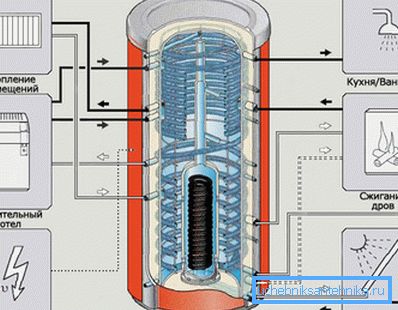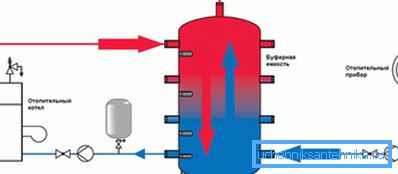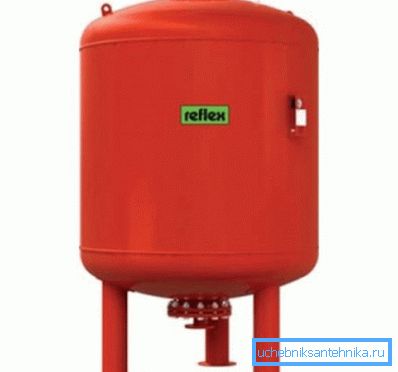Heat accumulator for solid fuel boiler: features
Solid fuel boilers are able to provide comfortable conditions in housing in cases where it is not possible to use gas as an energy source. Often, to achieve maximum heating efficiency, in such solid fuel systems heat batteries are used. In this article we will look at what these devices are and for what purpose they are used.

General information
What is a heat accumulator
A solid fuel heat storage tank is structurally a tank with a coolant, which is heated during combustion of the fuel in the combustion chamber of the boiler. After all the fuel in the boiler burns through, the heat accumulator gives its heat to the system, as a result of which the optimum air temperature can be maintained in the building for some time.
Working together with a modern boiler, the battery can significantly increase efficiency. In addition, the number of fuel bookmarks is reduced, which makes the operation of the boiler more convenient.

Purpose of the heat accumulator
In addition to the above function, the heat boiler performs several other tasks:
- Prevents the boiler from boiling as it absorbs superheated water and mixes it with the cooled. This function is very important, since in solid fuel boilers it is impossible to abruptly stop the heating process, as is the case with gas and electric appliances.
- Provides the ability to regulate the distribution of coolant in the circuits, turning on and off its flow on the signals of sensors. The latter can be located both indoors and outdoors. This allows you to create a comfortable temperature in the home with minimal human intervention.
- Ensures the stability of the indoor climate by turning on the water supply from the battery. Therefore, the device is also called the buffer capacity.
- Provides communication with other heating equipment, if there is one, for example, a gas or electric boiler.
- Allows to provide housing with hot water. However, for this, the tank must be equipped with a heat exchanger for hot water supply.
- Provides full burnout due to the fact that there is no need to limit cravings. This is due to an increase in heating efficiency.
From this we can conclude that the use of solid fuel boiler with heat storage is quite profitable.

Advantages of use
Among the advantages of using this device in the heating system, in addition to the above, the following points can be highlighted:
- Increase the life of the equipment and heating systems.
- System performance when working in different modes.
- Up to 30 percent fuel economy.
- The possibility of heating the room, even with complete combustion of fuel.
- Simple instruction manual.

disadvantages
Among the disadvantages of operating a system with a battery are the following points:
- High price of the device.
- Bulkiness, since the volume of the tank must be at least 500 liters. As a result, a separate room with a reliable and durable floor is required.
For these reasons, it is not always possible to use this device in the heating system.
Note! If the room does not have the condition for installing one large tank, it can be replaced with several smaller tanks.

The principle of operation of the heat accumulator
A heat accumulator is installed between the boiler and the heating system, which can include both standard radiators with a pipeline and a heated floor.
The process of the device operation is as follows:
- With the help of a circulation pump, water from the boiler enters the buffer tank and is mixed with the cooled liquid.
- At the same time, a similar amount of cooled coolant in the tank is sent to the boiler through the return pipe.
- When cooling water in the heating system, the second pump is triggered. As a result, the coolant from the buffer tank enters the battery through the pipeline. The second pump is located between the battery and the heating system, and is driven by a temperature sensor signal.
Note! In a closed heating system, it is imperative to use an expansion tank for heating and a safety valve.

At the same time the heating equipment has two cycles of work:
- Carried out by hand two bookmarks of fuel that burn through at maximum power. In this case, excess heat accumulates in the battery, and does not go into the surrounding space, as in the standard scheme.
- The boiler stops heating the coolant, while the specified temperature in the system is maintained by the release of heat from the battery.
I must say that when using modern buffer tanks, a simple heat generator can last up to two days. This parameter depends on the outdoor air temperature and heat loss of heated premises. (See also the article Convectors of heating: features.)
When buffering capacity is needed
As mentioned above, the cost of the equipment in question is quite high.
Therefore, it is advisable to use it when there really is a need for it, namely, in the following cases:
- The need to ensure efficient hot water supply in large volumes.
- In cases of use of fuel with a different coefficient of combustion. The device in this case allows you to smooth the peaks of combustion, as well as reduce the number of bookmarks.
- If in addition to traditional heating in the house uses a heat pump. In this case, the device can optimize the running time of the compressor.
Note! When choosing a tank, it is necessary to pay attention to the maximum pressure in the system for which it is designed. The thickness of the device walls depends on it. If, for example, the pressure in the system is high (4-8 bar), then it is necessary to purchase a device with a torospheric lid.

Calculation of the heat accumulator
In order to use the device in question really gave a positive result, it is necessary to correctly calculate the heat accumulator for a solid fuel boiler. I must say that there are many ways to solve this problem, however, if it is necessary to perform calculations quickly, then it is better to use a method that is well-proven in practice - one kilowatt of boiler power requires 25 liters of battery capacity.
Accordingly, the higher the power of the heating equipment, the greater the volume of capacity required. However, it is also necessary to take into account that in order for the system to work effectively, the power of the boiler must be 30 percent higher than with the standard calculation - for every 10 meters square 1 kilowatt.
Tip! Choosing models of boilers, it is better to give preference to devices whose walls are made of stainless steel. This will affect the durability of the battery, as it will not corrode.
Here, perhaps, all the main features of thermal batteries, having familiarized with them, you can make the right decision about using them.
Conclusion
Heat accumulators make solid fuel heating systems not only more efficient and economical, but also convenient to operate. However, it should be borne in mind that the equipment is quite expensive, besides heavy and overall. Therefore, it hardly makes sense to acquire it, for example, for the suburban volume in which you arrive from time to time.
From the video in this article, you can pick up some additional information on this topic.